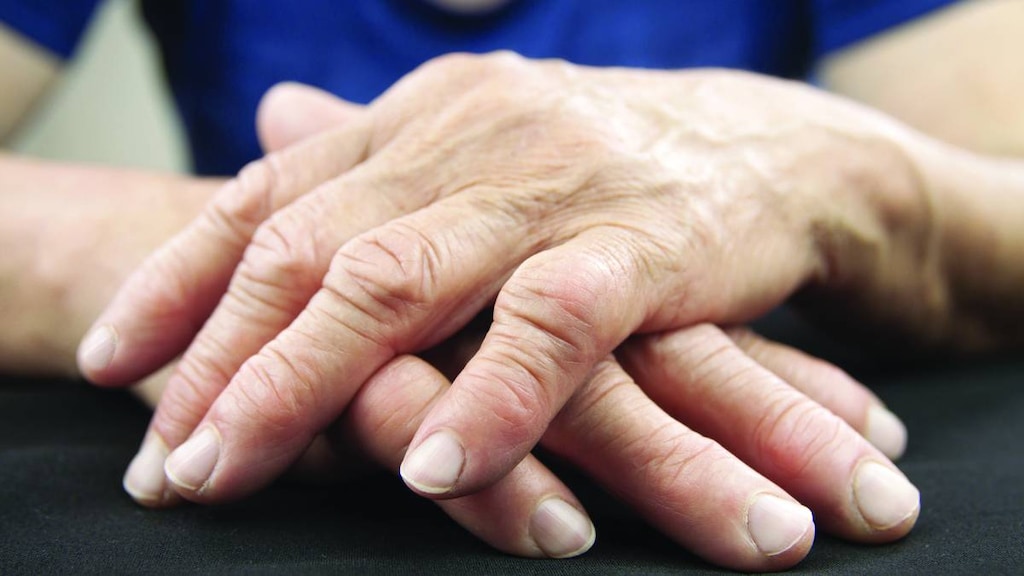Pharmacology
Mechanism of Action
Unknown, may decrease prostaglandin synthesis or may alter cellular mechanisms by inhibiting sulfhydryl systems
Pharmacokinetics/Pharmacodynamics
Excretion
Urine (60% to 90%); feces (10% to 40%)
Onset of Action
Delayed; may require up to 6 months
Half-Life Elimination
6 to 25 days; may be prolonged with multiple doses
Use: Labeled Indications
Rheumatoid arthritis: Adjunctive treatment of active rheumatoid arthritis.
Juvenile rheumatoid arthritis: Adjunctive treatment of juvenile rheumatoid arthritis.
Contraindications
Hypersensitivity to gold compounds or any component of the formulation; systemic lupus erythematosus; blood dyscrasias or a history of agranulocytosis, hemorrhagic diathesis or drug-induced granulocytopenia or anemia; renal disease; hepatic impairment; history of severe adverse effects with previous gold therapy (eg, bone marrow aplasia or other hematological disorders, exfoliative dermatitis, necrotizing enterocolitis, pulmonary fibrosis); significant dermatitis, including urticaria or eczema; pregnancy; breastfeeding.
Dosage and Administration
Dosing: Adult
Rheumatoid arthritis: IM: 10 mg first week; 25 mg second week; then 25 to 50 mg/week for an additional 20 weeks or until development of toxicity. For patients with modest improvement, a prolonged period of weekly injections may be maintained. For patients with a good to excellent response, continue 50 mg tapered progressively to every 2 to 4 weeks based on tolerability and response.
Dosing: Geriatric
Refer to adult dosing.
Dosing: Pediatric
Rheumatoid arthritis: IM: Initial: Test dose of 10 mg is recommended, followed by 1 mg/kg/week (maximum: 50 mg/injection); maintenance: 1 mg/kg/dose (maximum: 50 mg/injection) at every-other-week intervals for 2 to 20 weeks, then every 3 to 4 weeks. Early improvement may be observed after 6 to 8 weeks of therapy; months of therapy may be required before clinical improvement is observed.
Dosing: Adjustment for Toxicity
Mild to moderate reactions: Temporarily interrupt therapy; may be cautiously resumed 2 or 3 weeks after reaction has subsided. If therapy resumed, administer a test dose of 5 to 10 mg; if the test dose is tolerated, therapy may be cautiously continued in larger doses on subsequent injections at a decreased frequency.
Severe reactions: Permanently discontinue therapy.
Administration
IM: Deep IM injection into the upper outer quadrant of the gluteal region. Observe patient for 30 minutes after administration for anaphylactic reaction.
Storage
Store at 15°C to 30°C (59°F to 86°F). Protect from light. Should not be used if solution is darker than pale yellow.
Drug Interactions
Angiotensin-Converting Enzyme Inhibitors: May enhance the adverse/toxic effect of Gold Sodium Thiomalate. An increased risk of nitritoid reactions has been appreciated. Monitor therapy
Aspirin: May enhance the adverse/toxic effect of Gold Sodium Thiomalate. Specifically, liver function tests may be elevated when these agents are combined. Monitor therapy
PenicillAMINE: Gold Sodium Thiomalate may enhance the adverse/toxic effect of PenicillAMINE. Specifically, this combination may increase the risk for serious hematologic and/or renal adverse reactions. Avoid combination
Phenylbutazone: May enhance the adverse/toxic effect of Gold Sodium Thiomalate. Specifically, the risk for hematologic adverse effects may be increased. Monitor therapy
Adverse Reactions
>10%:
Dermatologic: Skin rash (30%)
Gastrointestinal: Mucous membrane lesion (20%)
Genitourinary: Proteinuria (10% to 15%)
1% to 10%: Hematologic & oncologic: Thrombocytopenia (1% to 3%), leukopenia (2%)
Frequency not defined:
Cardiovascular: Bradycardia, syncope, vasomotor symptoms (nitritoid reaction)
Central nervous system: Encephalitis, encephalopathy, Guillain-Barre syndrome, metallic taste, peripheral neuropathy
Dermatologic: Alopecia, blue-gray skin pigmentation (chrysiasis, irreversible), bullous dermatitis, erythema of skin, exfoliative dermatitis, pruritus
Endocrine & metabolic: Albuminuria
Gastrointestinal: Diarrhea, enterocolitis, stomatitis
Genitourinary: Nephrotic syndrome
Hematologic & oncologic: Agranulocytosis, aplastic anemia, eosinophilia, neutropenia, pancytopenia
Hepatic: Cholestatic jaundice, hepatotoxicity
Hypersensitivity: Anaphylaxis, angioedema, nonimmune anaphylaxis, tongue edema
Neuromuscular & skeletal: Arthralgia
Ophthalmic: Corneal deposits (gold)
Renal: Acute renal failure
Respiratory: Interstitial pulmonary disease, pulmonary fibrosis, pulmonary infiltrates
Warnings/Precautions
Concerns related to adverse effects:
- Dermatologic reactions: Dermatitis and lesions of the mucous membranes are common and may be serious; pruritus may precede the early development of a skin reaction. Consider alternative therapy in patients with dermatitis; may increase risk and/or symptoms of gold toxicity may be more difficult to detect. Use is contraindicated in patients with significant dermatitis, including urticaria or eczema.
- GI effects: Signs of toxicity include persistent diarrhea, stomatitis, and enterocolitis; avoid use in patients with prior inflammatory bowel disease.
- Hematologic effects: Signs of toxicity include hematologic depression (depressed hemoglobin, eosinophilia, leukocytes, granulocytes, or platelets). Use is contraindicated in patients with a history of blood dyscrasias or a history of agranulocytosis, hemorrhagic diathesis, or drug-induced granulocytopenia or anemia. Symptoms of gold toxicity may be difficult to detect in patients with prior abnormalities; consider alternative therapy.
- Hepatic effects: May be associated with the development of cholestatic jaundice. Use is contraindicated in patients with hepatic impairment.
- Hypersensitivity reactions: Rare hypersensitivity reactions, including anaphylactic shock, syncope, bradycardia, thickening of the tongue, difficulty in swallowing and breathing, and angioedema have been reported in association with injections of sodium aurothiomalate; treatment should be discontinued if these reactions occur. In addition, a vasomotor (nitritoid) reaction characterized by acute flushing and tachycardia may occur within minutes of injection; this reaction should be differentiated from anaphylaxis and therapy may be continued, but a careful evaluation of risk versus benefit should be undertaken and extreme caution should be exercised before resuming therapy, particularly in patients with cardiovascular disease.
- Pulmonary toxicity: May be associated with interstitial fibrosis; monitor closely.
- Renal effects: Renal toxicity ranges from mild proteinuria to nephrotic syndrome. Use is contraindicated in patients with renal disease.
Disease-related concerns:
- Cardiovascular disease: Use caution in patients with heart failure, hypertension, or cerebrovascular disease.
Concurrent drug therapy issues:
- Drug-drug interactions: Potentially significant interactions may exist, requiring dose or frequency adjustment, additional monitoring, and/or selection of alternative therapy. Consult drug interactions database for more detailed information.
Other warnings/precautions:
- Administration: Must not be injected IV.
- Experienced physician: Physicians should be experienced with chrysotherapy and should be familiar with the toxicity and benefits of therapy.
- Monitoring: Frequent monitoring of patients for signs and symptoms of toxicity will prevent serious adverse reactions.
Monitoring Parameters
CBC with differential, platelet count, hemoglobin determination, and urinalysis for protein, white cells, red cells, and casts, at baseline and prior to each injection. Skin and oral mucosa should be inspected for skin rash, bruising, or oral ulceration/stomatitis. Specific questioning for symptoms such as pruritus, rash, stomatitis or metallic taste should be included.
Pregnancy
Pregnancy Considerations
Gold crosses the placenta and accumulates in the fetus.
Use is contraindicated during pregnancy. Females of childbearing potential should be instructed to avoid pregnancy.
Patient Education
- Discuss specific use of drug and side effects with patient as it relates to treatment. (HCAHPS: During this hospital stay, were you given any medicine that you had not taken before? Before giving you any new medicine, how often did hospital staff tell you what the medicine was for? How often did hospital staff describe possible side effects in a way you could understand?)
- Have patient report immediately to prescriber signs of kidney problems (unable to pass urine, blood in the urine, change in amount of urine passed, or weight gain), signs of infection, signs of liver problems (dark urine, fatigue, lack of appetite, nausea, abdominal pain, light-colored stools, vomiting, or yellow skin), signs of lupus (rash on the cheeks or other body parts, sunburn easy, muscle or joint pain, chest pain or shortness of breath, or swelling in the arms or legs), mouth irritation, mouth sores, metallic taste, bruising, bleeding, severe loss of strength and energy, flushing, severe dizziness, passing out, itching, rash, blood in the urine, severe diarrhea, difficulty swallowing, or signs of ulcerative enterocolitis (severe abdominal pain; black, tarry, or bloody stools; or vomiting blood) (HCAHPS).
- Educate patient about signs of a significant reaction (eg, wheezing; chest tightness; fever; itching; bad cough; blue skin color; seizures; or swelling of face, lips, tongue, or throat). Note: This is not a comprehensive list of all side effects. Patient should consult prescriber for additional questions.
Intended Use and Disclaimer: Should not be printed and given to patients. This information is intended to serve as a concise initial reference for health care professionals to use when discussing medications with a patient. You must ultimately rely on your own discretion, experience, and judgment in diagnosing, treating, and advising patients.




